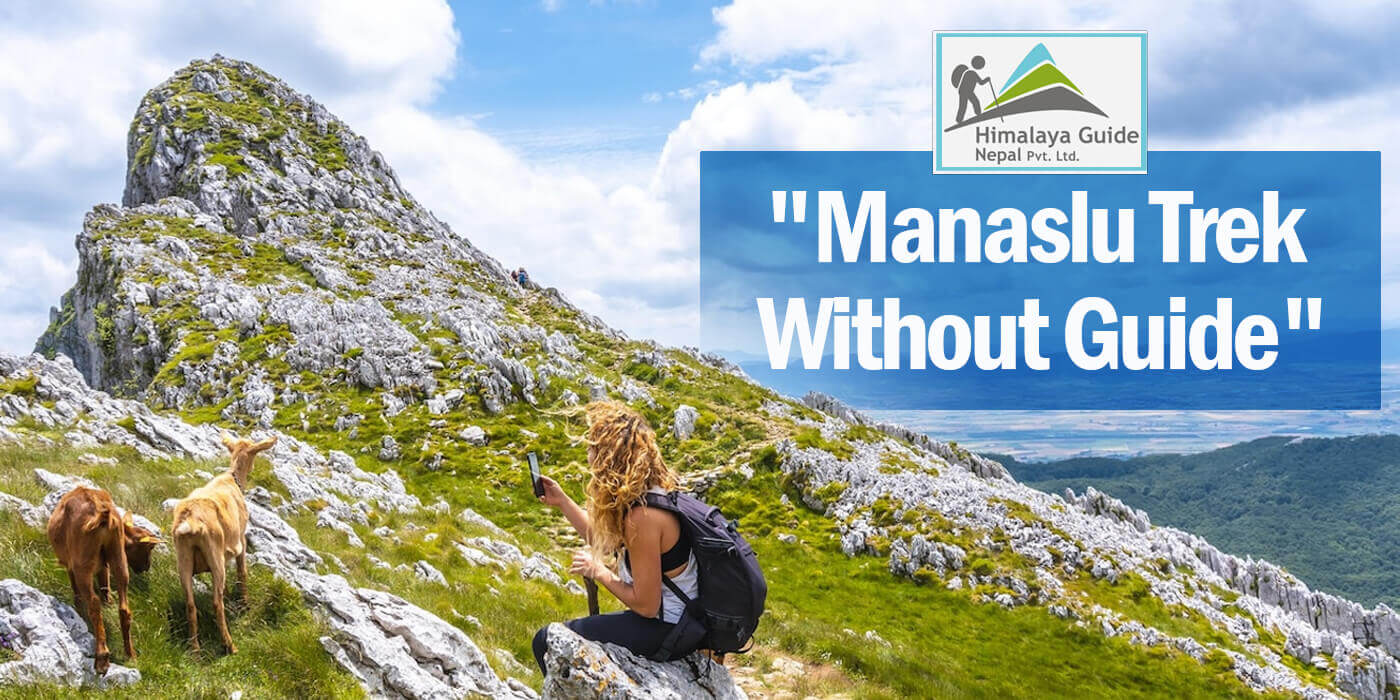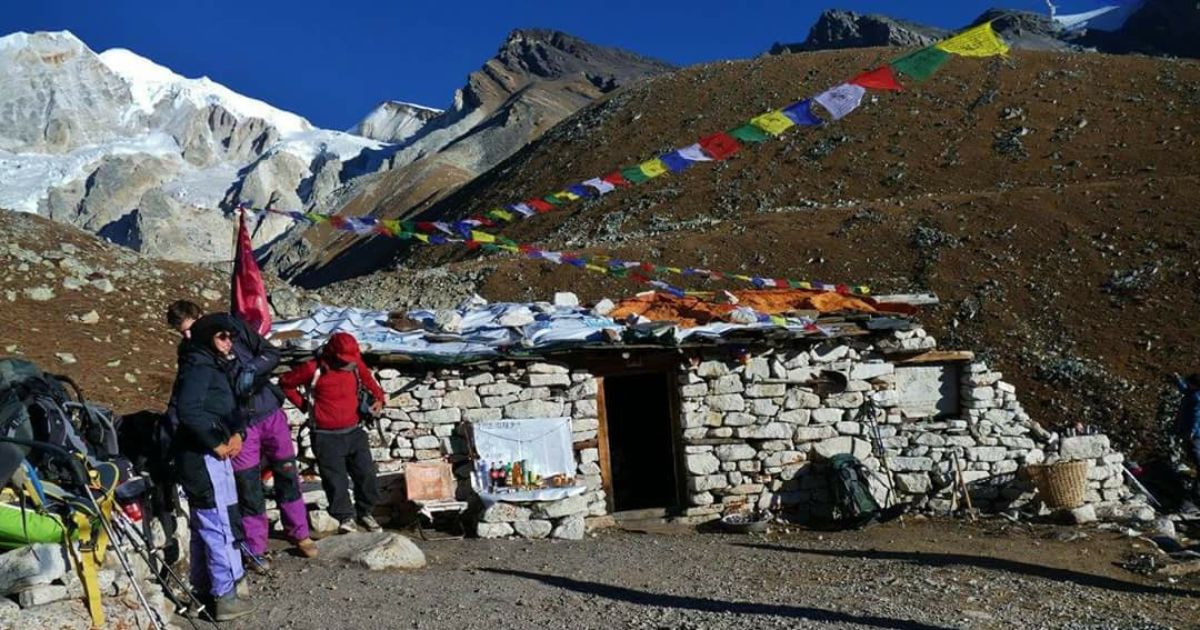Manaslu Trek Without Guide

8 Sep 2022 Chandra Gurung
Introduction
A Solo Trek to the Manaslu Region certainly sounds like a splendid idea until you realize that this venture is literally prohibited by the Nepalese Government. With special attention to preserving the local culture of the remote, rustic villages of the Manaslu Circuit, ‘ Manaslu Trek without a guide ‘ is only a fictitious matter.
Once you’ve discovered that, the next question on your mind will most definitely be, “But why?” This article aims to provide you with an appropriate justification for this topic.
Reasons behind the government ban on ‘Manaslu Trek Without Guide’:-
1. Altitude Sickness:
The primary reason for prohibiting solo treks is for the traveler’s safety. The Manaslu Circuit is a trek that extends over regions of varying elevations, with trekkers required to hike ascents of roughly a kilometer uphill daily.
Even with proper acclimatization, travelers are left vulnerable to acute altitude sickness due to the region’s atmosphere. In order to tend to these possible dangers, a guide has been made a mandatory prerequisite for all trekkers along this route.
Altitude sickness can be recognized within a day of considerable ascent by symptoms of headache, loss of coordination, lethargy, nausea, dizziness, cough, shortness of breath, loss of appetite, and several other similar symptoms. Even though most of these common symptoms can easily be mistaken for altitude sickness, a seasoned veteran is more likely to tell them apart, and this can make the difference between truth and speculation. More importantly, given the fact that you’re spending a good deal of money to experience this tour, feelings of animosity can arise in the case that you are provided with a false diagnosis, preventing any further journeys on your trip.
2. Language Barriers:
This area is close to the Tibet Border, and many communities here are heavily influenced by their tradition and culture. Even the native Nepalese people have trouble communicating with the locals here, given their nuanced dialects. Hiring a local guide who is familiar with the residing communities here is wiser. It doesn’t matter how well-versed you are with your non-verbal skills; the risk is not worth mentioning.
To avoid miscommunication, your certified guide will assist you regarding all matters—be it small talk or inquisition into the native lifestyles and livelihoods. Traveling as a stranger to an unfamiliar land threatens the people living in this area; as by the laws of human nature, any outsider/stranger is prone to suspicion in any scenario. Your local guide carries such a sense of responsibility, as they will act as a mediator between the local people and you, ensuring that all your interactions are smoothly carried out.
3. Collection of Information/Statistics:
Since tourism is one of Nepal’s major activities, it is essential to understand the consumer end of the business, because it is the only variable factor in the equation. The activities and interests of the visitors are a deciding element for sustainable growth and conservation of these coveted areas. Only with a proper understanding of such vital factors can positive development be made.
Data collection is the only guaranteed way to make sense of what goes on and what’s to be. This is not an intrusion of privacy upon the tourists but only a general database of their preferences. What draws them(particularly) to such locations is an essential question in the minds of the trekking agencies and almost all the other businesses concerned with this route/industry. Any drawbacks or complaints during the trips are gathered in the form of constructive feedback, through which implementations to improve the overall experience of the journey are made possible. The hospitality industry benefits significantly from such data, and they can adjust their supply, amenities, and offers with a greater understanding of the visitors they face each year.
4. Prevention of any Mishaps or Unfavorable Circumstances:
With a strong foundation of data about the people visiting this route, all regulatory bodies are able to make monumental choices for the betterment of the overall touristic experience in this region.
As the old adage goes ‘guest is god’, visitors need to be taken proper care of, and any accidental mishap leaves the concerned parties accountable. This ethic is enforced through comprehensive processes like the computerized database. Systematic information gathering on the routes and the businesses along the trail is a preemptive measure against any possible dangers. Reducing the margin for error of such incidents is made possible with the help of a fixed, concrete, and structured course of action such as there.
The information on the trekking areas, routes, and the institutions that are all involved, along with the duration of their stays, helps search and rescue operations become more efficient and effective. The safety and Security of the traveler are prioritized well ahead in this manner.
5. Generation of Local Employment:
Here’s the obvious one (often mistaken by dense fools to be the only reason).
Being born in the Himalayas presents you with an unorthodox skill set, in contrast to the qualities/attributes that generally create employment in other advanced economies. Confused? For starters, the average native in the Himalayas has a keen sense of attunement with nature (sometimes to an extent where he/she has proper conversations).
Praying to supernatural forces present in all non-living objects is a common belief among people here. This belief can be traced back to animism, a core principle across many religions that are predominant in the Sacred Himalayan Landscape. Such a relationship brings forth a respectful and yielding temperament that is key to understanding life in the Himalayas.
Another exceptional quality would be the ability to habitually traverse severe slopes and downhill terrain, a very reassuring background as a mountain companion. Besides that, the people’s unwavering optimism and good-humored nature make them suitable for positions related to the tourism industry.
Conclusion:

Although the trek is not possible without a guide, this does not in any way imply that you aren’t capable of undertaking this trek alone. For reasons mainly pertaining to the area’s conservation and collection of data, the region has been off-limits for all solo trekkers. Because of this, a government-authorized, licensed guide is required.
If you plan on going without a guide, you can hire a porter with a guide license, including insurance and food+accommodation. The porter will handle luggage up to 15kgs.
“Manaslu Guide” is a government register perfect trekking guide in Nepal. We have been working for 18 years with a local guide and strong porter in the Manaslu area.
The Manaslu Team has extensive experience in the Nepal tourism sector. A family group of employees works for our business as it is a local trekking agency in Nepal.
Frequently Asked Question:
Q: Is a Trekker’s Information Management System (TIMS) card statutory for the Manaslu Trek?
No. You do not require a TIMS card for your Manaslu Circuit Trek unless you head into the Annapurna Circuit Region from Dharapani.
Q: What happens if you’re caught without a guide and/or permit?
If you’re bold enough to brave the restricted region without proper documentation, you should be ready to face the music. By that, we mean the music of luck and mercy of the designated regional police authorities. Penalties can range from doubled fine rates and immediate removal from the restricted region.
Q: What permits are required for the Manaslu Trek?
Excluding the Tsum Valley Permit (Lokpa to Mu Gompa): a total of two permits that are issued by a government-registered trekking company are required. (liable to change)
- Special Restricted Permit for Manaslu Trek: This permit is required in the region passing through Jagat to Larkya Pass, with a minimum of a week’s issuance, extended upon request. The cost for the permit is 100$ per week and an additional 15$ per day afterward. (Sept-Nov). The rate drops down to 75$ per week + 10$ a day (extension) from December to August.
- Manaslu Conservation Area Project Permit (MCAP): 30$ per person for the entire trip. You will need to produce this permit at checkpoints from Philim to Samagaun, and the cost is constant all year round.
Q: What documents do I need in order to apply for a permit?
To obtain a permit, you need to have the following documents:
- A photocopy of your passport
- Printout of online application form stating the total number of trekkers for the trip
- A valid VISA
- Names and detailed information of all the trekkers
- Trekking itinerary
- An assurance letter from the company
- An up-to-date tax clearance document of the trekking company
- Travel Insurance for the accompanying staff
- Certified copy of the company from the Ministry of Tourism, Culture and Civil Aviation
- A Certificate of Nepal Rastra Bank, authorizing the exchange of foreign currencies
- Registered Certificate of Permanent Account Number (PAN or VAT)
- Payment Voucher from Bank
Q: Is it possible to apply for my Manaslu Circuit Trek permits in advance?
Yes. Arrangements can be made accordingly. You can reach out to us with e-copies of your flight tickets, passport, and VISA number.
